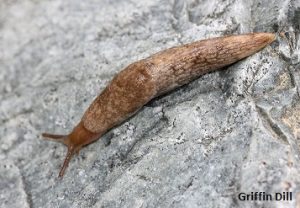Slugs
Pest Management Fact Sheet #5036
James F. Dill, Pest Management Specialist
Clay A. Kirby, Insect Diagnostician
For information about UMaine Extension programs and resources, visit extension.umaine.edu.
Find more of our publications and books at extension.umaine.edu/publications/.
Description & Biology
Slugs are legless, boneless creatures. They are similar to snails, but have a raised mantle on the back instead of a shell. Slugs overwinter mostly as eggs, but adult slugs can survive Maine winters if they hide in areas protected from freezing.
The gray garden slug is the most common and most destructive. This ¾-inch pest varies in color from whitish yellow to nearly black, with brown specks and mottling.
The spotted garden slug, also known as the giant slug or leopard slug, can range from 3 to 7 inches long. These slugs become lighter in color as they age. The yellowish mantle usually has three rows of black spots that continue to the end of the body. The species is found primarily on islands and along the coast, but it is slowly becoming more common inland as well.
The tawny garden or yellow slug length extends to about 3-4 inches. It is usually recognized by its yellow mantle, and lighter spots on a yellow body. This type is less common than the gray garden or spotted garden slugs.
- Gray Garden Slug, Deroceras reticultatum
- Spotted Garden Slug, Limax maximus
- Tawny Garden Slug, Limacus flavus
The approximately 100 eggs laid by female gray garden slugs or by male garden slugs (slugs are hermaphroditic) are about 1/8-inch in diameter. A four-inch slug may produce eggs up to a ¼-inch in diameter. It takes about 100 days for slug eggs to hatch at 32° to 40° F, but only 10 days in warmer weather (late May, for example). Under ideal conditions of damp, warm weather, the life cycle of a slug is about three months.
Young slugs damage plants by rasping away the surface of plant leaves. Adults also chew holes in leaves and frequently leave slime trails on commercial plants, thus reducing salability.
Management
Slugs need moist areas, protection from sun and wind, and nourishment to speed their growth and increase their populations. Good sanitation can deprive them of most of these needs. It helps to remove boards, rocks, logs, leaves and dense growth. It is also wise to minimize shaded areas, rock walls, rock gardens, or forested borders and leave bare ground or close-cropped grass next to any vegetable or flower beds.
Slugs avoid crawling over anything dry, dusty or scratchy, such as lime, road dust, diatomaceous earth, cinders, coarse sawdust, gravel or sand. Secretion of enough mucus to free themselves from these materials soon exhausts them and they die as a result. A border of any of these inert materials, therefore, helps control slugs. It is also reported that hydrated lime, Bordeaux mixture or urea repels slugs. Remember, however, lime affects the pH of soil. Never use salt as it renders soil inhospitable for most plant growth.
A fly screen, four inches wide, placed on its edge and partly embedded in the soil for support, keeps slugs out of an area. Boards, bark, or other materials not less than six inches square make effective traps when placed in gardens. Each morning you can gather any slugs from under the traps and destroy them. An hour spent hand-picking and destroying slugs can noticeably reduce the overall population. Slugs can be kept from potted plants by placing the pots on boards or other supports with water in a pan beneath them. Alternatively, wrapping stems with cotton batting may keep slugs off plants. Copper tape is commercially available as a slug barrier and is especially effective in raised bed plantings.
Toads are slugs’ most important natural enemy. Many people claim that several ducks will keep a garden slug-free.
Slugs are attracted to–and drown in–shallow dishes or aluminum pie plates containing beer or baker’s yeast dissolved in water. Set the top edges of the dish at ground level and cover loosely with a board so slugs can easily get into the mixture.
Iron phosphate and metaldehyde baits are also effective in controlling slugs. Be sure to read the pesticide label carefully for information on bait placement and permissible crops. It is best to read the label before you purchase the material.
When Using Pesticides
ALWAYS FOLLOW LABEL DIRECTIONS!
Pest Management Unit
Cooperative Extension Diagnostic and Research Laboratory
17 Godfrey Drive, Orono, ME 04473
1.800.287.0279 (in Maine)
Information in this publication is provided purely for educational purposes. No responsibility is assumed for any problems associated with the use of products or services mentioned. No endorsement of products or companies is intended, nor is criticism of unnamed products or companies implied.
© 2016, 2018, 2020 | Reviewed: 2023
Call 800.287.0274 (in Maine), or 207.581.3188, for information on publications and program offerings from University of Maine Cooperative Extension, or visit extension.umaine.edu.
In complying with the letter and spirit of applicable laws and pursuing its own goals of diversity, the University of Maine System does not discriminate on the grounds of race, color, religion, sex, sexual orientation, transgender status, gender, gender identity or expression, ethnicity, national origin, citizenship status, familial status, ancestry, age, disability physical or mental, genetic information, or veterans or military status in employment, education, and all other programs and activities. The University provides reasonable accommodations to qualified individuals with disabilities upon request. The following person has been designated to handle inquiries regarding non-discrimination policies: Director of Equal Opportunity, 101 Boudreau Hall, University of Maine, Orono, ME 04469-5754, 207.581.1226, TTY 711 (Maine Relay System).




